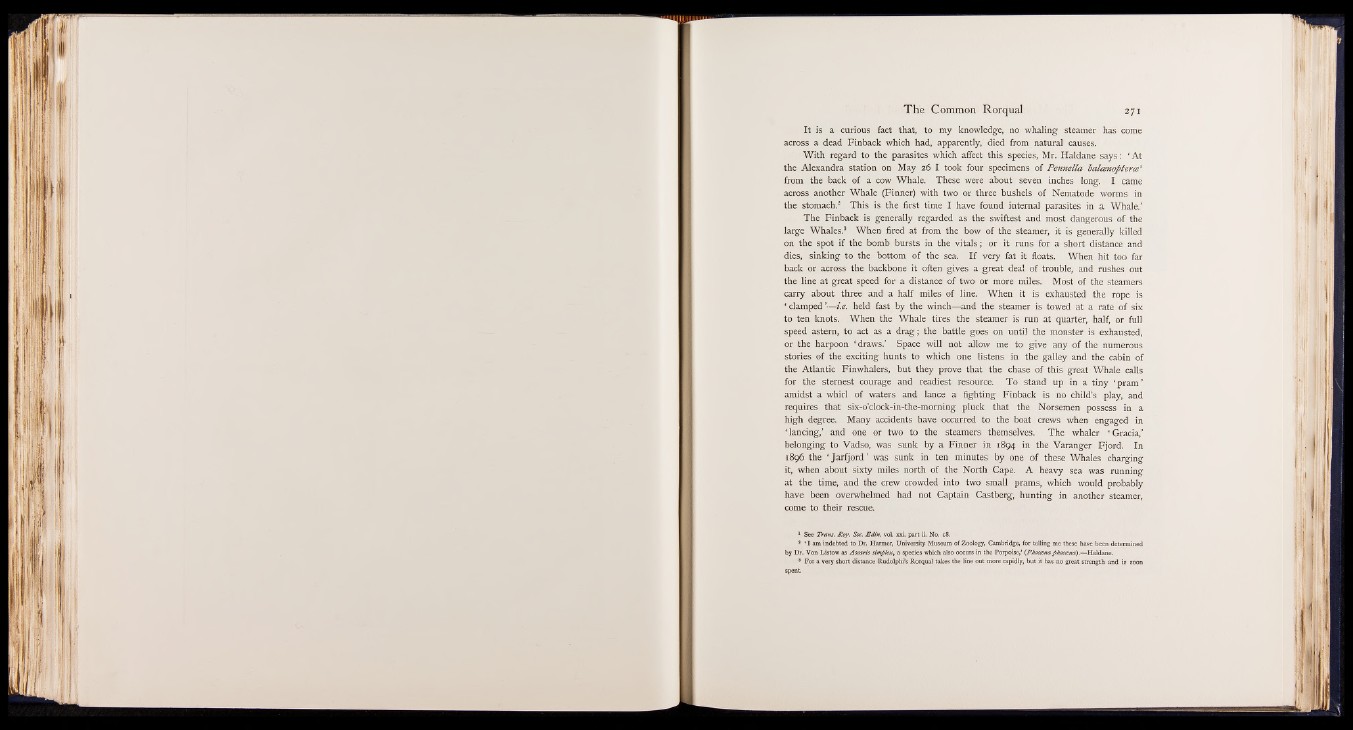
The Common Rorqual 271
It is a curious fact that, to my knowledge, no whaling steamer has come
across a dead Finback which had, apparently, died from natural causes.
With regard to the parasites which affect this species, Mr. Haldane says: ‘ A t
the Alexandra station on May 26 I took four specimens of Pennella balcenoptercP
from the back of a cow Whale. These were about seven inches long. I came
across another Whale (Finner) with two or three bushels of Nematode worms in
the stomach.2 This is the first time I have found internal parasites in a Whale.’
The Finback is generally regarded as the swiftest and most dangerous of the
large Whales.8 When fired at from the bow of the steamer, it is generally killed
on the spot if the bomb bursts in the vitals; or it runs for a short distance and
dies, sinking to the bottom of the sea. I f very fat it floats. When hit too far
back or across the backbone it often gives a great deal of trouble, and rushes out
the line at great speed for a distance of two or more miles. Most of the steamers
carry about three and a half miles of line. When it is exhausted the rope is
‘ clamped ’— i.e. held fast by the winch— and the steamer is towed at a rate of six
to ten knots. When the Whale tires the steamer is run at quarter, half, or full
speed astern, to act as a drag; the battle goes on until the monster is exhausted,
or the harpoon ‘ draws.’ Space will not allow me to give any of the numerous
stories of the exciting hunts to which one listens in the galley and the cabin of
the Atlantic Finwhalers, but they prove that the chase of this great Whale calls
for the sternest courage and readiest resource. To stand up in a tiny ‘ pram ’
amidst a whirl of waters and lance a fighting Finback is no child’s play, and
requires that six-o’clock-in-the-morning pluck that the Norsemen possess in a
high degree. Many accidents have occurred to the boat crews when engaged in
‘ lancing,’ and one or two to the steamers themselves. The whaler ‘ Gracia,’
belonging to Vadso, was sunk by a Finner in 1894 in the Varanger Fjord. In
1896 the ‘ Jarfjord’ was sunk in ten minutes by one of these Whales charging
it, when about sixty miles north of the North Cape. A heavy sea was running
at the time, and the crew crowded into two small prams, which would probably
have been overwhelmed had not Captain Castberg, hunting in another steamer,
come to their rescue. 1
1 See Trans. Roy. Soc. Edin. vol. xxi. part i i No. 18.
s ‘ I am indebted to Dr. Harmer, University Museum of Zoology, Cambridge, for telling me these have been determined
by Dr. Von Listow as Ascaris simplex, a species which also occurs in the Porpoise,’ (Phoaena pkoccena).— Haldane.
* For a very short distance Rudolphi’s Rorqual takes the line out more rapidly, but it has no great strength and is soon